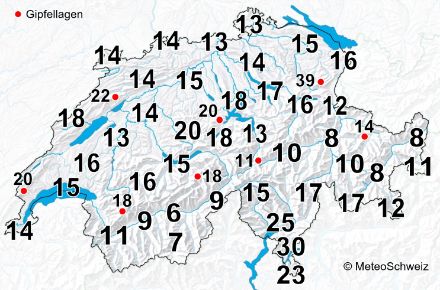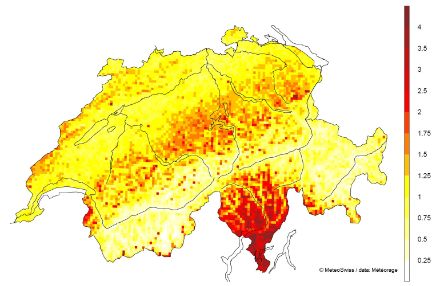Service Navigation
Search
In order for thunderstorms to develop, warm, humid air is needed. These conditions are fulfilled on the south side of the Alps on many summer days. The Alpine Divide also contributes significantly to the formation of thunderstorms: when warm, humid Mediterranean air flows over the Alps, the rapid uplift of the warm air into a much cooler environment causes an additional vertical upward movement.This often triggers violent thunderstorms.
In the dry interior of the Alps, such as in the Valais, northern and central Graubünden and the Engadine, there is much less humidity, and thunderstorms are a relatively rare occurrence in those areas.
On the north side of the Alps, in central Switzerland, there is slightly more thunderstorm activity, which may be attributable to the Napf region. In typical thunderstorm conditions, when warm, humid air is carried from the south-west over the Lake Geneva basin to the Swiss Plateau, the Napf area is the first major obstacle in the way of the flow. Here, too, the rapid uplift of air leads to condensation, which then releases heat. This causes the upward movement of the air to be further accelerated. As a topographic obstacle, the Napf thus serves as the ideal starting point for thunderstorm formation.

Summertime is thunderstorm season
In all regions of Switzerland, thunderstorm activity peaks in the warm summer months, from June to August. Winter thunderstorms are rare throughout Switzerland. In the high Alpine valley of the Upper Engadine, no thunderstorms were recorded in the winter months of December to February in the period from 2000 to 2024.
Lightning frequency in Switzerland
MeteoSwiss has data on lightning strikes dating back to the year 2000. The analysis shows that 1 to 2.5 lightning strikes per square kilometre are recorded annually on the Swiss Plateau. The frequency of lightning strikes in a year is more than three per square kilometre, occurring predominantly on ridges and summits. In southern Ticino, the frequency is highest at low altitudes, with more than three lightning strikes recorded annually per square kilometre.

Mean lightning frequency in Switzerland
When a broad average is taken of the annual lightning strikes across the different regions, the result for Switzerland as a whole is about 1.5 lightning strikes per square kilometre annually. Averaged over the long term, this means Switzerland has around 60,000 to 80,000 lightning strikes per year, counting only the main lightning strikes and not secondary ones. Given that there are often one to two secondary lightning strikes per main strike, the total number of lightning strikes per year is actually around 150,000.
A rough, uncertain estimate of the total number of lightning flashes per year over Switzerland, i.e. strikes plus lightning between clouds, is probably about two to three times the number of lightning strikes.